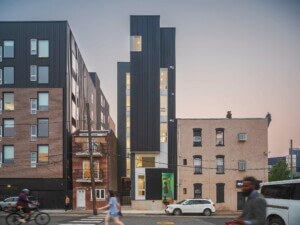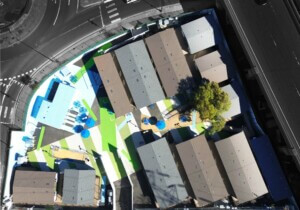For the duration of the coronavirus (COVID-19) crisis, AN will use this column to keep our readers up to date on how the pandemic is affecting architecture and related industries. This weekly article is meant to digest the latest major developments in the crisis and synthesize broader patterns and what they could mean for architecture in the United States. The previous edition of the column can be found here.
While the coronavirus pandemic continues to pummel the United States, it is hitting certain populations harder than others, particularly Black, Latinx, and Indigenous people. The New York Times reported on Wednesday that the CDC released its first national data tracking race among COVID-19 patients, which showed that in March, “the percentage of Black [hospitalized COVID-19] patients (33 percent) was much higher than the percentage of African-Americans in the population as a whole.” Local data from cities and states tracking race among COVID-19 patients showed that the health disparity is even worse in certain areas: In Louisiana, about 70 percent of the people who have died are Black, though only a third of that state’s population is; “African-Americans account for…72 percent of virus-related fatalities in Chicago, even though they make up a little less than a third of the population,” according to the Times; the virus has killed more people in the Navajo nation than in the much larger state of New Mexico; and, as of Thursday, all of the people who have died in St. Louis so far from COVID-19 complications have been Black.
Why is this the case?
The answer could have something to do with architecture, particularly housing. According to public health experts, while other factors, like biases in healthcare and higher rates of heart disease and diabetes, certainly play a role in the racial coronavirus disparities, crowded housing in low-income neighborhoods could be facilitating the spread of the disease and increasing “weathering,” or the wear and tear of environmental stresses on the body, which increases the severity of coronavirus cases.
Urban design inequities also almost certainly play a role in transmission. Even with social distancing rules in full effect, subway stations in predominantly Black and Latinx neighborhoods in the Bronx in New York City are packed with commuting essential workers.
“COVID-19 has been a magnifying glass on the weaknesses in our systems,” said Kimberly Dowdell, principal at HOK and president of the National Organization for Minority Architects (NOMA). Though racialized housing disparities are nothing new, the stark death toll of the pandemic is harshly illustrating those disparities’ effects.
“There’s a saying that when America sneezes, the Black community catches a cold,” Dowdell said, pointing to an enormous wealth gap between Black and white Americans as one of the main reasons why Black people in the U.S. suffer more acutely during crises like the current one.
The Brookings Institution recently reported that in 2016, the net worth of a typical white American family ($171,000) was nearly ten times greater than that of a typical Black American family ($17,150). While a variety of discriminatory policies have sowed the seeds for the current imbalance, racist urban planning has played an enormous part. Redlining, which started in the early 20th century and continues in some form today, is a term for the once-legal practice of denying investments and bank loans to predominantly Black neighborhoods—banks would outline such areas in red on maps. The practice discouraged investment in Black-owned homes and businesses, which lost value over generations, resulting in not only a racial wealth gap but spatial disparities, as well. Many predominantly Black neighborhoods have fewer grocery stores, are closer to polluting industries, and lack high-quality affordable homes.
Even after the pandemic subsides, vulnerable populations will still be at risk from the next crisis and will potentially be in even a weaker state. One answer, Dowdell said, is for communities to invest in predominantly Black and BIPOC neighborhoods to decrease the wealth gap and increase resiliency. That kind of recovery will require a mix of policy, development, and design professionals working together, ideally with teams that reflect the communities they’re serving.
“Diverse teams are really important,” Dowdell said. “Architecture should reflect the communities that they serve from a racial perspective.”
Dowdell pointed to Chicago, where she lives, and where Mayor Lori Lightfoot has focused on the city’s racialized spatial inequality in her mission to eliminate endemic poverty within a generation.
“If there’s a team that goes into certain communities, it would be great if there were certain people who were from that community or at least have some level of familiarity with the culture and of the community,” Dowdell said. “For example, if we’re looking at the South Side of Chicago [which is over 90 percent African American], and you don’t have African-African team members, that’s a missed opportunity.”
Building teams that reflect underserved neighborhoods could be more difficult after the pandemic, as the economic downturn may be harder on architects who come from those areas.
“I do think that Black communities are going to have a harder time recovering,” Dowdell said. “It’s going to be a challenge for everyone, but I think that given the wealth gaps, architects of color will probably struggle to get back to where they were.”
As jobs, internships, and salaries decline, even if only temporarily, as a result of the pandemic, those without a cushion of family money or who financially support loved ones could have to leave the profession for greener pastures. The racial wealth gap means that Black and BIPOC architects may flee in greater numbers, damaging diversity in a profession that is already overwhelmingly white. As of 2019, only 2 percent of NCARB certificate holders identify as Black or African American, and less than 1 percent identify as Latinx.
What can architects do? Dowdell touted NOMA’s national network as a way for architects of color to support each other and find opportunities, including the group’s new NOMA Foundation Fellowship, which offers a stipend and internship for architecture students. NOMA is also launching a new weekly web series, “Stay All In for NOMA,” which will help members stay informed during the pandemic.
Dowdell suggested that architects get involved with local NOMA chapters to organize and advocate for city and state planning policies that invest in underserved neighborhoods. For those already working on projects advancing social justice, NOMA is partnering with the NAACP and the SEED Network advocacy group on the Design Awards for Justice, Equity, Diversity and Inclusion (JEDI), which will recognize excellence in those categories.
“No matter what,” Dowdell said, “an architect can do something.”
In other corona news from this week, AN covered new hospitals and healthcare spaces deployed for the pandemic, and the AIA’s new assessment tool for adapting existing buildings into coronavirus treatment sites. The crisis continues to demand innovative thinking, and in Florida, autonomous vehicles are delivering medical supplies. For the housebound, we also highlighted many exhibitions you can check out from home, including robot-assisted gallery tours, a French show exploring AI and architecture, virtual Frank Lloyd Wright tours, and a virtual exhibit on a balmy shore. We picked some books to catch up on, too.
Enjoy, and be well!











